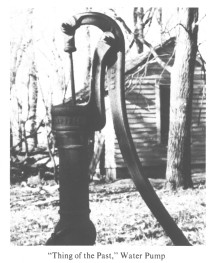ETHNIC BACKGROUND
People came to the county from many lands. However, the majority came from points to the East in the United States.
The three largest culture groups to settle in the county from Europe were: The Czechs, the Germans, and the Swedes. There were many others who came but in lesser numbers. Many came from Denmark. One such settlement was in south central Pohocco and Marietta Precincts. The Irish settled in many places - a large group came to Center Precinct around the Colon area. There were also many in north Pohocco and Leshara Precincts.
The first naturalization papers issued in the county were made out for Thomas Johnson, a native of Denmark, on May 12, 1873. The same day, Alexander Graham and Peter Campbell of Great Britain took out papers.
George Elbling was the first Austrian to be naturalized on May 26, 1874, and on the same day the first Swede was John Hanson. The first Bohemian received his papers. James Craig came from Scotland. Henry Smith was the first from Holland; David Robert was the first from France; and from Prussia, the first was John H. Wagermann.
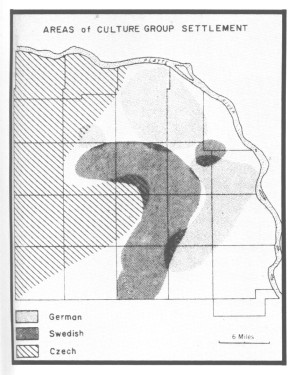 |
| Areas of Culture Group Settlement |
CZECH CUSTOMS
The first Czech settlement in Saunders County was made by Peter Kastl who homesteaded southwest of Prague in 1867. He and the hundreds of Czechs who followed him to this county brought with them the Czech language and many traditions and customs. Many American Czechs still enjoy speaking the Czech language. If someone approaches you and says, "Vitame Vas," don't be alarmed. He is just saying "We Welcome You."
Christmas time is a time of much tradition for the Czechs. The table is festively decorated for the traditional Christmas Eve dinner. At the center of the table is a large candle and a large bowl of fruit and walnuts. The menu consists of halibut or codfish, potatoes, vegetables, the braided "vanocka", commonly known as "houska." This bread has almonds and raisins in the dough and has a fruited glaze on top. Other specialties made are kolacky, apple strudel, cookies, and rye bread.
Other foods made and enjoyed by Czechs include liver dumpling soup, filled fruit dumplings, potato dumplings served with goose, duck, or pork, and sauerkraut. Jaternice and jelita, two sausages, are still made in some Czech homes.
There is a special art to decorating a Christmas tree in the old Czech manner. First, the candles are put on the tree. Other typical decorations are fruit, nuts, and gingerbread cookies. Small red apples are decorated with pieces of jelly bean candy and raisins. Walnuts are gilded and tied with a ribbon. Cookies, cut into shapes of birds, dolls, and stars and then frosted with icing, add to the tree decorations. Finally the tree must have its strings of popcorn, cranberry, and paper chains.
The early Czech pioneers went to the environment to find pine or cedar trees. Most didn't have the money to buy small candles. For decorations, they used popcorn, nuts, and dried wild plums strung together on string, and also paper chains. Later, they were able to buy glass ornaments.
Another traditional folk art of the Czechs is the decorating of eggs. The Czech word for painted Easter eggs is "kraslice." The word comes from a Czech word meaning beautiful. The oldest method of dyeing eggs is to use natural vegetable dyes. Onion skins produce a warm orange-brown tone. Spring grains, clover, birch or ash leaves, and parsley produce greens. Today's Czechs use modern dyes for the eggs.
Patterns on Easter eggs are made by various means. A sharp knife or needle is used to scratch a design on a dyed egg. Designs are also painted on the egg with wax. After the egg is dyed and the wax removed, the design in white is quite striking. Some of the most beautiful "kraslice" are now done in oil or acrylic paints, using geometric designs or scenes of children, lambs, birds, chickens, and May-Poles.
Czechs in Saunders County are still enjoying Czech music. Both young and old enjoy attending polka dances. Dance bands in the area provide polka and waltz music, as well as popular music, when performing for local dances. Churches with Czech descendants in their congregations sing an occasional Czech hymn at their services. The Saunders County Czech Singers provide entire programs in the Czech language.
With the development of Czech clubs has come an interest in the traditional Czech costume. Different areas of Czechoslovakia have their own unique styles of costumes. In this country, the costumes follow a basic design. The ladies wear full, gathered skirts of a bright color. The skirt is trimmed with rows of lace, embroidery, and edgings. A weskit or vest is also brightly trimmed. A fancy apron over the skirt, a blouse with billowing sleeves, all beautifully embroidered, and black boots usually complete the outfit. The men wear black trousers, vests trimmed with embroidery, and white shirts. Each outfit is unique, and completely different from the others.
Some Czechs of today still make their own sauerkraut. A few strip feathers to make feather quilts and pillows. A few still make pastry brushes from the larger feathers of ducks and geese. Many Czechs, both young and old, are still enjoying the card game called "Tarok."
In the early days there was a society in Wahoo called the C.S.P.S. Lodge, meaning in Bohemian "Cesko Slovansky Podpornjici Spolek" and when translated into English is "Bohemian Slovanic Benevolent Society."
Though there are many traditions and customs other than the ones mentioned, the traditions of hard work, perseverance, and neighborliness are still prevalent in the Czech people. From information by Wm. T. Vavak
THE SAUNDERS COUNTY CZECH CLUB
The Saunders County Chapter of Nebraska Czechs, Inc. was organized in 1970. Mrs. Art Storm invited a group of Czech descendants to her home on May 4, the purpose being to form a Czech group to become a Chapter of Nebr. Czechs, Inc. The goal was to help preserve the culture, arts, and language of the Czech people. The charter members attending that meeting who are still active members are: Mrs. Milo Svoboda, Mrs. Joe Houska, Sr., Mrs. William Vavak, and Miss Georgia Sudik. The officers elected were: President, Mrs. Art Storm; First Vice President, Mrs. Joe Houska, Sr.; Second Vice President, Mrs. Joe Hradsky; Secretary, Georgia Sudik; Treasurer, J. Divis; and Historian, Mrs. William Vavak.
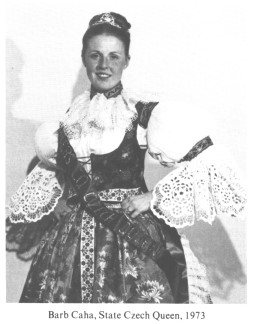 |
| Barb Caha, State Czech Queen, 1973 |
One of the outstanding projects of the chapter is choosing a Czech queen. Each chapter chooses one. She then represents her chapter in the State Queen Contest, held during Czech Days in August in Wilber, home base of the state organization. The organizers felt that the Queen contest would develop an interest among the young folks. The requisites of queen candidates are (1) unmarried girl, (2) 17-21 age bracket, (3) high school graduate, (4) Czech costume of girl's own or local creation (imports not permitted), (5) be at least one-fourth Czech, and (6) must give a 5-minute performance of her talent.
Carol Svoboda, daughter of Mr. and Mrs. Milo Svoboda, was the first to represent our chapter. Our 1973 queen, Barbara Caha, was chosen state queen. Barbara wore a costume which she and her mother had designed, elaborately decorated with embroidery. She served our chapter well. In 1982 our queen, Marian Meduna, was chosen Nebraska State Czech Queen. She and her mother also designed and beautifully embroidered her costume.
A Czech adult chorus was formed in 1972. In 1974, Lucille Kremlacek, Malmo, and her junior singers became a part of our chapter. Her group and the adult singers began filling numerous engagements.
Each chapter is urged to have a festival or heritage day. We decided on our first heritage day in 1973 in Wahoo at Neumann High. The program consisted of numbers from various chapters and from our state queen. A skit put on by our chapter was a re-enactment of the early Christmas Eves. The Wm. Vavak family decorated a huge tree, which was brought from the farm of Mrs. Agnes Kubalek, Mrs. Vavak's mother. The singers, acting as the carolers, were accompanied on the violin by Bernard Klased of Wilber. This number touched the hearts of many Czech pioneers present.
page 13
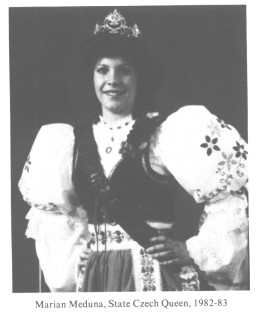 |
| Marian Meduna, State Czech Queen, 1982-83 |
A project that had long been worked on was to have the Czech language taught at the University of Nebraska, Lincoln. At last that became a reality. Our chapter issues an annual scholarship to a Saunders County student of one-fourth Czech heritage. Our first winner was Don Vrana.
In the spirit of fellowship, we send birthday cards to Czech heritage residents at various nursing homes. Mrs. Roman Maly has had charge of this project for several years, having mailed out hundreds of cards. The families of the residents are pleased.
Our chapter has had 2 state presidents, Mrs. Art Storm and Jim Sousek. When Wisconsin was organizing their state Czech organization, they called on Nebr. Czechs, Inc. for help. Going to Wisconsin was our state president, Jim Sousek, and his wife, Charlotte.
Raffles often were a part of Heritage Day activities. Businesses donated for these raffles. In appreciation, the chapter made donations of a colored TV to the County Care Center, a bulletin board to Haven House, portable TVs to the hospital, and an electric shaver to the hospital. E.A. Texel and Milo Svoboda carried on these raffle projects. In addition, $132 was allowed to buy books for the Wahoo City Library and the Fremont City Library. In fall of 1982, Dr. Vlad Kucera completed his recent book, Czech Folklore. Georgia Sudik donated a copy to the Wahoo City Library in memory of her family, the late Joe Sudik Sr. Family. The book contains two chapters pertaining to the Sudik family. Submitted by Georgia Sudik
SAUNDERS COUNTY CZECH SINGERS
The Saunders County Chapter of Nebraska Czechs, Inc. was organized in May, 1970. The president, Mrs. Arthur Storm, stressed the importance of music to the Czech people. With this in mind the Saunders County Czech Singers were organized. The charter members were Blanche Booth of Malmo, Mary Havelka, Milo Svoboda, Pearl Houska, and Joe Hradsky, all of Wahoo, Anna Hynek of Prague, Emil Kobza and Georgia Sudik of Colon, Vaclav Beranek, Morse Bluff, and Mildred Pacal, Malmo. Miss Sudik was the director and piano accompanist. This group made their first public appearance at Wilber "Czech Days" in August, 1972. They sang "Musiky, Musiky, Musite Krasna Hrat" while Mary Havelka and her brother, Joe Hradsky, danced. After that they appeared at various Czech festivals and other community activities.
In 1975, Mrs. Edward (Lucille) Kremlacek became the director and accompanist. Her piano accordion proved to be an advantage. The group was able to appear at many more places. Good pianos are getting scarce.
Quoting Lucille, "In 1975 we continued the adult singers, who were started by Miss Sudik. I now accompany the group with the accordion. We meet every Wednesday night at our home. We have from 25 to 30 in the group." The group enjoys singing the 90 or so different Czech songs, hymns, and Christmas carols they have learned.
This singing group has appeared at all the different Czech festivals and Czech doings - at Omaha, Lincoln, Hastings, David City, Dwight, Brainard, Wilber, Wahoo, Weston, Prague, Schuyler, Clarkson, and also at the Nebraska State Fair. They have sung for several different church services, both Catholic and Protestant. They have taken part in, and sung for, several church centennial celebrations, and for Christian Women Christmas programs.
Best of all, the group enjoys singing at nursing homes, Care Centers, or Senior Citizen homes. It seems memories are brought back to the resident people as they recognize different Czech songs that were popular and sung during their youth.
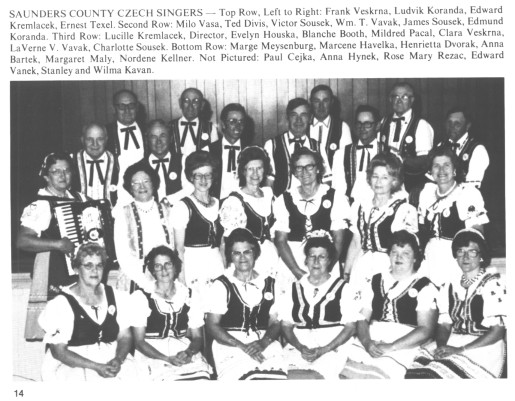 |
| SAUNDERS COUNTY CZECH SINGERS - Top Row, Left to Right: Frank Veskrna, Ludvik Koranda, Edward Kremlacek, Ernest Texel. Second Row: Milo Vasa, Ted Divis, Victor Sousek, Wm. T. Vavak, James Sousek, Edmund Koranda. Third Row: Lucille Kremlacek, Director, Evelyn Houska, Blanche Booth, Mildred Pacal, Clara Veskrna, LaVerne V. Vavak, Charlotte Sousek. Bottom Row: Marge Meysenburg, Marcene Havelka, Henrietta Dvorak, Anna Bartek, Margaret Maly, Nordene Kellner. Not Pictured: Paul Cejka, Anna Hynek, Rose Mary Rezac, Edward Vanek, Stanley and Wilma Kavan. |
On April 2, 1891, a Bohemian paper was established in the county. It was one of the first independent papers published in the Bohemian language in the United States. It was necessary as few of the early Bohemians could read English. Submitted by Saunders Co. Czech President Wm. T. Vavak
SWEDISH SETTLEMENTS
The first Swedish settler was one Wall, who had settled on Sand Creek near the present site of Colon sometime between 1866 and 1868. This Wall and family had come as far as Nebraska City with a lot of Mormon emigrants but they separated and made the aforementioned settlement. They resided in the area until about 1883 when they sold out and moved to Salt Lake City.
In the year 1863 emigrated from Horjo, Forsmaling, Kristianstad Lan, Sweden, the widow Johanna Berggren with her sons, N.B. and A.L. and Olof, and Martin, and Nellie. The family stopped in Chicago and the eldest son, N.B., found work with the noted gardener and horticulturist, Mr. Peterson, of Rose Hill, a suburb of Chicago. He soon became Mr. Peterson's trusted foreman.
Mr. N.B. Berggren was a young man of vim and energy. He had heard of the opportunities of the west for young men. In 1866, he went on a tour of investigation and his trip extended as far west as Burt County, where already a Swedish settlement had been started. He was well-pleased with the land in that county; but hearing that the state capital was to be moved south of the Platte, his business sagacity suggested to his mind the advantages of securing land closer to the capital of the state. He, therefore, crossed the Platte and beheld the beautiful Prairie of Saunders County. At that time there were no settlers in the center of the county except those mentioned. On the present site of Lincoln, the only signs of human inhabitation were two sod houses.
The following year, 1867, Mr. Berggren returned to Nebraska, and at Fremont secured a wagon and team in conjunction with two gentlemen who were going to stake out a mail route to the new state capital. Axes and spades were taken along, and when Wahoo Creek was reached, a half a day was spent in bridging the same.
On October 12, 1867, Mr. Berggren filed on Sec. 32, T15, R7, and at the same time filed for 15 other settlers among whom were L. Christiansen, Otto Huchlander, A.L. Berggren, Jonas Sandberg, Eric Finwall, A. Plumbgren, Frank Peterson, John Johnson, and Nels Nelson.
On March 5, 1868, Mr. N.B. Berggren and the rest of those who had made their filings five months before, settled on their respective homesteads and from them dated the flourishing Swedish settlements of Saunders County. Letters were sent to Sweden describing the rich and promising land they had taken possession of and the grand opportunities it afforded to secure a home in the Swedeburg settlement.
In the spring of 1869 arrived, direct from the same Province as Berggren of Sweden, thirty families all of whom settled around where the two Swedeburg Churches are now located. Among these were the following: N.A. Aspengren, Nels Jonson, Truls Person, John and Magus Erickson, John and Nels Gibson, John and Mons Martinson, Nels Eliason, Hans Hanson, Hans Hokanson, and A.G. Quick. In the fall of that same year the settlement received a further reinforcement of about 100 families. It is impossible to secure all the names, but in the church records on April 20, 1870, the following names, not yet mentioned, were listed; Sam Peterson, Martin Jeppson, Carl Carlson, Bengt and Oke Swenson, Samuel Peterson, (Linkoping), Olof Olson, A.G. Olson, Peter Olson, P.E. Anderson, A.G. Goranson, C.J. Larson, Swen Swenson, A.P. Wallin, Andrew Eliason, Hokan, Olson and Truls Hokanson.
To L. Isaacson, Malmo, grain dealer, belongs the honor of being the first Swedish family in that part of the county. He also hails from Kristianstad-Lan, Sweden and emigrated in 1868 and arrived in Omaha in the month of May, 1868. He came and settled on his homestead in Saunders County in 1869. He did not remain alone for more than two
page 14
weeks, when Mr. Andrew Blomberg came from Omaha with a colony of Swedes direct from Dalcadia, noted for its brave men and handsome women and located on the beautiful and productive prairie surrounding the present Malmo. The following are some of those who settled around Malmo in 1869 and '70: L.T. Bruce, J. Bredenberg, A. Helsing, P. Blomberg, A. Rosenberg, J. Nelson, J. Larson, L. Ljungstrom, Bengt Olson and three sons, Jacob and John Frostrum, L. Lundberg, O. Nelson, P. Nelson, P. Pherson, Per. Olson, J. Erickson, H. Hokason, M. Erickson, H. Hokanson, N. Eliason, Olof Boostrum.
The three Bruces mentioned are direct descendants of the Scottish Chieftain Brice, the family having fled from Scotland to escape with their lives from the tyranny of the British Government. They settled in Sweden and are now transplanted and taken firm and permanent root in the new republic.
In the year of 1867, the county was invaded by a Swedish emigration from another quarter. A Baptist colony settled seven miles north from the present site of Mead and was called the Estina settlement from the post office of that same name. Those colonists came mainly from Minnesota and Moline, Ill. and were from the northern part of Sweden. Among them were the following: Andrew, John, A. and Gulick Wicklund, O.P. Hjeltman, A. Ekquist, L.E. Lund, Louis Anderson, P. Olson (Franzen), and in 1870 came C.E. Uppman from Brooklyn, N.Y.
The settlement made by N.B. Berggren and his company in 1868 can be properly classed as belonging to the Mead settlement. They united and organized the first Swedish church in the county on the 15th of January of 1870. Others coming in 1869-70 to Mead are: Swen Hedenschog, A. Larson from Nykoping, and his two sons, Lewis and Gust Monteen. The Larsons came on June 10, 1869. P. Henning arrived in Omaha on June 9, 1860 and in November, 1870, he homesteaded but returned to Omaha to work. J.A. Allmen, Andrew Hallner, Pehr Olson, N.J. Heldt, P. Gibson, A. Larson, and S.A. Janson also arrived in 1869.
In the spring of 1869, G. Sandberg settled on Sec. 6, T13, R9 three miles from Memphis. About the same time came Peter Thulin, Andrew Larson, Eric Charling.
Peter Thulin: - "I came to Nebraska in the spring of 1868 with $10 in my pocket, a sick wife to care for but no children. Today I have a wife and 10 children (1893), 640 acres of the finest land that lay out of doors. I settled in Saunders County in the spring of 1869 ten miles northwest of Ashland on eighty acres of Uncle Sam's land. The first two years I lived in a sod house and had to haul water for household purposes and for the stock two miles from Wahoo Creek. We drank warm water in summer and sucked ice in winter. I have raised corn and sold the same for 10 cents to a $1 a bushel. Wheat from 25 cents to $1.25, hogs from $1.90 to $8 per hundred. I have been hailed out, eaten up by grasshoppers and chinchbugs, drowned out and dried out but still I 'hold the fort' on the old homestead. It would take $40,000 to buy me out of all my property today. I have one daughter and one son attending Wesleyan University and I am 50 Years old." by Alice Graham
SWEDISH CUSTOMS AND TRADITIONS IN SAUNDERS COUNTY
The Swedish people have made important contributions to Saunders County. As immigrants they endured hardships in order to gain a better life. The building of the Union Pacific Shops in Omaha in 1865 provided work for many newcomers. Some were anxious to acquire land so they came to the prairies of Saunders County. They dug holes in the hillsides and roofed them with brush. These were later replaced by sod houses or frame shacks if wood was available. They were a serious and religious people so next they built churches and schools. They were industrious, frugal, law-abiding and progressive. These people settled in Wahoo, Malmo, Swedeburg, Mead and Ceresco.
National costumes in Scandinavia tend to vary considerably from one district to another, not only reflecting the wealth of the wearer and the dressmaker's skill but many times the age of the dress for the dress (or parts of it) is often handed down from generation to generation. Gold adornments play an important role in a bride's dress being part of the headdress, belt and gown. Exquisite rose embroidery and silver filigree is typical in a Norway costume. They also include fancy aprons, boleros and caps.
Popular Swedish songs are: Stora Gud, Skona Maj, Hosiana, Du gamla du Friska, Trygarre Kan Igen Vara, Jesus Alskar Mig Jag Vet, Skynda till Jesus, Kom latom oss pa barnavis, Gode Herde Led och Bar Oss, Ach Vermeland du Skona, Och Flickan Hon Gar i Dansen and The David Psalms.
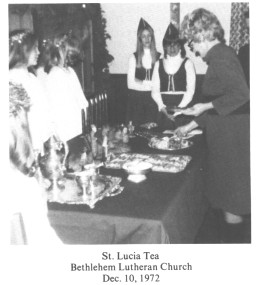 |
St. Lucia Tea
Bethlehem Lutheran Church
Dec. 10, 1972 |
Traditions are Dop i Gryta meaning "Dip in the Pot"; Christmas Eve Supper with a visit from Santa Claus; Easter Egg Breakfast; Goose Dinner on November 11; Crayfish Party August 8; June Midsummer Festival with May Pole Dancing. The Julotta Church Service at 5 A.M. was special but modern times have changed the hour of this worship service; having an Advent Calendar, wreaths and stars, good Swedish coffee made with egg; lighting of candles formerly in windows and on trees. Early in the morning of December 13 in Sweden a very unusual celebration takes place. This is Santa Lucia Day and is also celebrated in Wahoo. Lucia is the "Queen of Lights." She reminds that Christmas is near and that longer and sunlit days are approaching. In Sweden she wakes sleeping members of the family and serves them coffee and a special kind of bun. In Wahoo, they have an afternoon candle-lite coffee hour with many beautiful Swedish decorations with young people dressed in costume doing the serving. Blue and yellow are the Swedish colors. Viking is a name associated with many sports, cafes and clubs. "Kaffe Kalas" is an afternoon party enjoyed by women.
Swedish foods are: Lutfisk, Sillsallad, Mjolksas, Kottbullar, Potatiskorv, Kalvsyita, Potatis, Pankaker, Kaldomar, Kokt-rodkal, Bruna bonor, Inlagd gurka, Gronsallad, Ragbrod, Skorpor, Saftsoppa, Ostkaka, Risgrynskaka, Spritsar, Pepperkakor, Sockerkaka, Polka griser and Appleknyten. These foods are found at Smorgasbords. Swedish people like ice-cream topped with strawberries and they are fond of many kinds of cheese. Eggnog is also a favorite. Gladys C. Swanson
THE GERMAN PEOPLE
The German immigrants that settled in the Yutan area were a very hard working people. Most came with very little money or possessions, either working on farms or acquiring a team of horses and a walking plow to start farming. One man told of plowing sixty acres, walking behind a walking plow.
They raised and butchered their own meat, rendering lard, made sausage in casings. They cured their hams and bacon in outdoor smoke houses, using saw dust which was let to smolder for weeks. Head cheese, pickled pig feet, blood sausage and many other dishes were made; very little was ever wasted. Every family had a flock of chickens. Hens would be set on eggs each spring to raise chickens for summer meat and for eggs.
At corn picking time, the children, especially the boys, would be kept home from school to help with the harvest. It was a very special time when harvest was finished. It called for a celebration and a big meal.
For entertainment they would have barn dances and house parties. Some one would play an accordion or mouth harp. Some of these parties would last all night and part of the day. The older people would come in the afternoon to play cards and drink beer. The younger people would come after the daily chores were done and join in the dancing in the evening.
The German people were mostly a church-going nationality. They had their own German-speaking congregation. Some would only take time to come to church on Easter to take Communion that one time for the year.
The Yutan community is still predominantly German. The farmers use the most modern methods and equipment to keep up with the changing times. Submitted by Mildred Mumm.
ROADSIDE CROSS
The roadside cross near Linwood is a part of a tradition dating back over 100 years. On a hill far away - stands an old rugged cross...
The cross which stands on Ed Hovorka's hill southeast of Linwood is not particularly old or rugged. However, a religious and historical tradition is deeply ingrained in its redwood configuration standing eight feet tall.
The present cross is the most recent replacement for the original cross which had been erected in that area by immigrant settlers.
Having arrived before the establishment of area churches, the pioneers constructed a cross to serve as a gathering place for Sunday prayer service. The cross was maintained even after local churches were started as a landmark and symbol of early pioneer faith.
The roadside cross tradition was almost lost when the second-to-latest cross was removed in 1952 on account of a road-widening project. There was no cross then for 24 years.
"It was a Bi-Centennial year and a lot of older people always asked if it was still here. So we decided to put it up," said Ed Hovorka, in explaining why he and his wife, Viola, re-established the tradition by erecting the present cross in 1976.
Hovorka said his family has owned the farm where the cross stands since the 1920's. The cross then standing consisted of 6 x 6 timbers on which hung a tin impression of Christ.
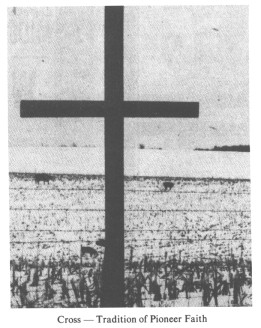 |
| Cross -- Tradition of Pioneer Faith |
page 15
Hovorka said this cross was removed during a WPA road project in the 1930's and not replaced until the 40's. This second-to-latest cross was erected by Albert and Cyril Codr of Linwood, plus Joe Brousek of Bruno.
The exact number of crosses which have been erected are in question. Mrs. Ed Cerny of Rogers said there may have been four or five. Her late husband's grandfather, Frantisek Cerny, came to America from Moravia in April, 1873, with his family and associates. The story related to Mrs. Cerny is that these people erected the cross after settling on Linwood homesteads.
It's later thought, said Mrs. Cerny, that Frantisek's son, Joe Cerny, renewed the cross after the original one deteriorated.
The cross has been used by travelers to determine their location between Linwood and Prague and other intermediate points.
Hovorka said he had the present cross made at a Schuyler lumber yard. Its redwood construction should guarantee its longevity.
OLD SETTLERS PICNIC
The first Saunders County Old Settlers Picnic was held in the Wilcox grove, seven and a half miles northeast of Mead, in Union Precinct, on August 20, 1885. Rev. Peter Lansing was chosen the first president. The people came from miles around in wagons, spring wagons, on horseback or on foot. One of the main features of the day was the big picnic dinner, spread on one long table, and everyone enjoyed the bounteous supply of good food prepared for the occasion. A program followed with the pioneers telling of their early experiences. It was voted to make this an annual affair, the date being the third or fourth Thursday of August each year.
The second year Alonson Smith was president, and it was held in the T.L. Adams grove where there was excellent shade and a good ground adjacent for baseball and other sports. It was held here until 1889 when it was voted to hold the picnic in different groves in eastern Saunders County, including the courthouse grove in Wahoo. The name was changed to Old Settlers Biographical and Historical Association of Saunders County. Each person upon joining was to give short biographical sketch of himself, and the secretary was to receive ten cents per one hundred words for recording these events. Early records show only men as members. Evidently there were no pioneer women or else men were carrying the pocket book.
In 1899, Mr. John J. Johnson of northwest Marietta Precinct was influential in bringing the picnic back into the Mead area. It was held in the grove on their farm. The attendance grew, and the reunion was moved to Mead's school grounds, now the Mead Park, and was held here for 42 years.
A large tent was erected each year for the program. In the early 1930's, an open air pavilion was built to take the place of the tent. Many prominent Nebraskans, including Governors, spoke at the afternoon program. Comedies by the Robert Reed Players of Lincoln were oftentimes given in the evening, followed by a fireworks display. In 1931, Mead's American Legion Jr. League baseball team was state champion and was featured on the program. Their coach was Paul Cook, a teacher at Mead.
The golden anniversary of the reunion was held in 1935. It was estimated a crowd of 4000 attended. The board of directors at this time were: R.C. Johnson, Pres., Henry Ostenberg, Fred Swanson, Albert Benson, George Nelson, Jay Adams, Anton Wicklund, and Emmanuel Swanson.
In 1942, during World War II, no celebration was held. During the war, attendance dropped, and in 1947 the eleven member committee decided to discontinue holding the event. However, in 1967, Nebraska's Centennial year, a picnic was held with county-wide participation.
Other presidents of the association to serve throughout the years were: W.D. McCord, J.J. Johnson, E.H. Willcox, B.M. Reese, Samuel Wooley, D.H. Thompson, B.M. McCord, C.H. Gustafson, and Wm. Mitchell.
The Old Settlers Picnic was truly a fun time for many people to renew acquaintances.
|

